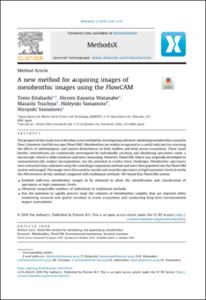| dc.contributor.author | Kitahashi, Tomo | |
| dc.contributor.author | Watanabe, Hiromi Kayama | |
| dc.contributor.author | Tsuchiya, Masashi | |
| dc.contributor.author | Yamamoto, Hideyuki | |
| dc.contributor.author | Yamamoto, Hiroyuki | |
| dc.date.accessioned | 2023-06-06T16:46:03Z | |
| dc.date.available | 2023-06-06T16:46:03Z | |
| dc.date.issued | 2018 | |
| dc.identifier.citation | Kitahashi, T., Watanabe, H. K., Tsuchiya, M., Yamamoto, H., and Yamamoto, H. (2018) A new method for acquiring images of meiobenthic images using the FlowCAM. MethodsX, 5, pp.1330–1335. DOI: https://doi.org/10.1016/j.mex.2018.10.012 | en_US |
| dc.identifier.uri | https://repository.oceanbestpractices.org/handle/11329/2251 | |
| dc.description.abstract | The purpose of this study was to develop a new method for investigating sediment-inhabiting meiobenthos using the Flow Cytometer And Microscope (FlowCAM). Meiobenthos are widely recognized as a useful indicator for assessing the effects of anthropogenic and natural disturbances in both shallow and deep ocean ecosystems. These small benthic invertebrates are traditionally investigated by individually counting and identifying specimens under a microscope, which is labor intensive and time consuming. However, FlowCAM, which was originally developed to semiautomatically analyze microplankton, has the potential to resolve these challenges. Meiobenthic specimens were extracted from sediment using the centrifugal separation method and were then pipetted into the FlowCAM system and imaged. The images were then used to classify and count the specimens at high taxonomic levels to verify the effectiveness of this method compared with traditional methods. We found that FlowCAM system:
• Enabled sufficient meiobenthic images to be obtained to allow the identification and classification of specimens at high taxonomic levels.
• Obtained comparable numbers of individuals to traditional methods.
• Has the potential to rapidly process large the volumes of meiobenthos samples that are required when monitoring seasonal and spatial variation in ocean ecosystems and conducting long-term environmental impact assessments. | en_US |
| dc.language.iso | en | en_US |
| dc.rights | Attribution 4.0 International | * |
| dc.rights.uri | http://creativecommons.org/licenses/by/4.0/ | * |
| dc.subject.other | Environmental monitoring | en_US |
| dc.subject.other | Meiobenthos | en_US |
| dc.subject.other | Benthic invertebrates | en_US |
| dc.subject.other | FlowCAM | en_US |
| dc.subject.other | Seasonal variation | en_US |
| dc.title | A new method for acquiring images of meiobenthic images using the FlowCAM. | en_US |
| dc.type | Journal Contribution | en_US |
| dc.description.refereed | Refereed | en_US |
| dc.format.pagerange | pp.1330–1335 | en_US |
| dc.identifier.doi | https://doi.org/10.1016/j.mex.2018.10.012 | |
| dc.subject.parameterDiscipline | Rock and sediment biota | en_US |
| dc.subject.instrumentType | flow cytometers | en_US |
| dc.subject.dmProcesses | Data analysis | en_US |
| dc.subject.dmProcesses | Data aggregation | en_US |
| dc.subject.dmProcesses | Data acquisition | en_US |
| dc.bibliographicCitation.title | MethodsX | en_US |
| dc.bibliographicCitation.volume | 5 | en_US |
| dc.bibliographicCitation.issue | 12 | en_US |
| dc.description.sdg | 14.a | en_US |
| dc.description.maturitylevel | Concept | en_US |
| dc.description.adoption | Novel (no adoption outside originators) | en_US |
| dc.description.sensors | Flow Cytometer And Microscope (FlowCAM) | en_US |
| dc.description.methodologyType | Method | en_US |
| obps.contact.contactname | Tomo Kitahashi | |
| obps.contact.contactemail | tkitahashi@jamstec.go.jp | |
| obps.resourceurl.publisher | https://www.sciencedirect.com/science/article/pii/S2215016118301699#se0155 | |
 Repository of community practices in Ocean Research, Applications and Data/Information Management
Repository of community practices in Ocean Research, Applications and Data/Information Management

